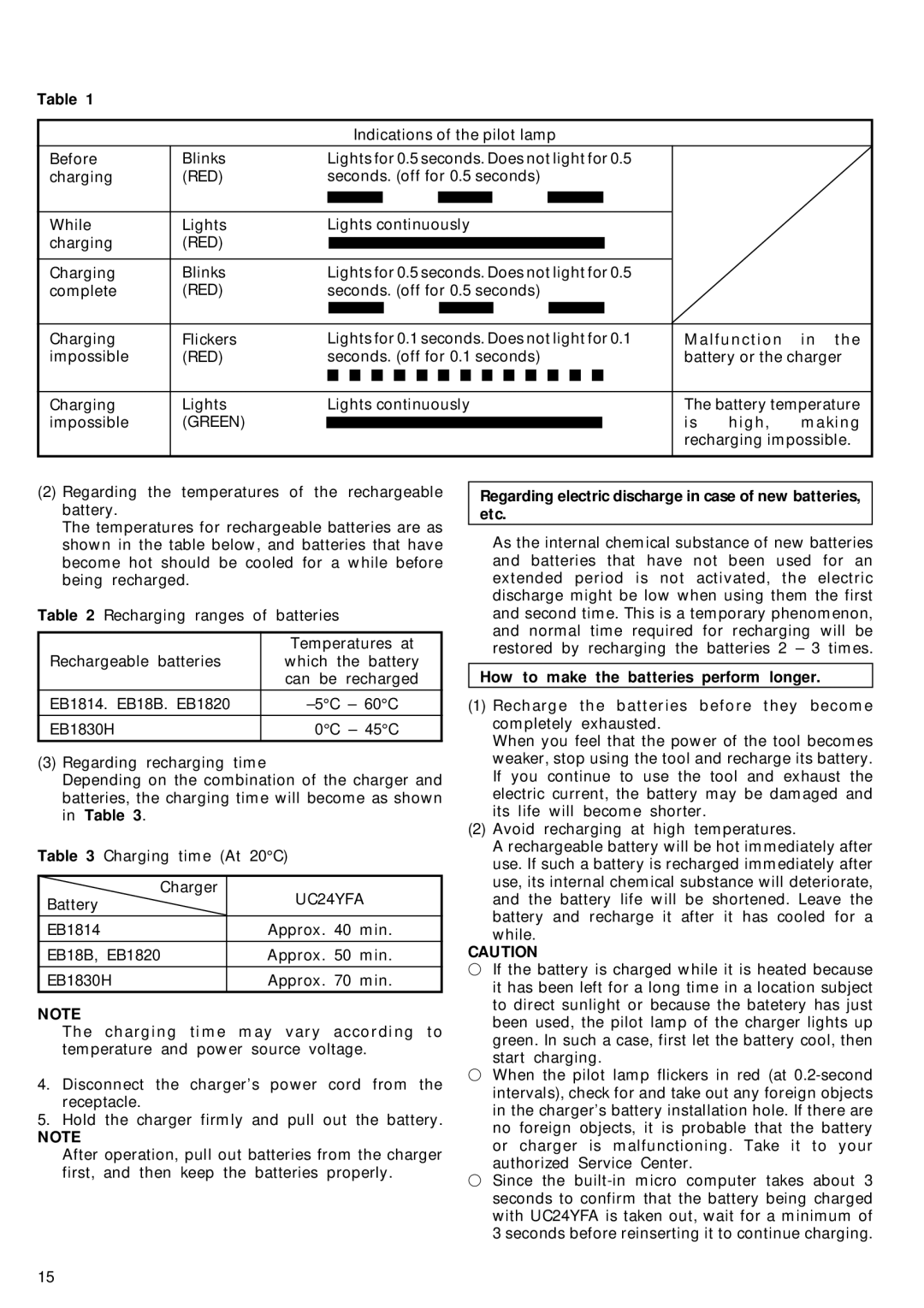
Table 1
Indications of the pilot lamp
Before charging
While charging
Charging complete
Charging impossible
Charging impossible
Blinks | Lights for 0.5 seconds. Does not light for 0.5 | ||||||||||||||||||||||||||||
(RED) | seconds. (off for 0.5 seconds) | ||||||||||||||||||||||||||||
|
|
|
|
|
|
|
|
|
|
|
|
|
|
|
|
|
|
|
|
|
|
|
|
|
|
|
|
|
|
|
|
|
|
|
|
|
|
|
|
|
|
|
|
|
|
|
|
|
|
|
|
|
|
|
|
|
|
|
|
Lights | Lights continuously | ||||||||||||||||||||||||||||
(RED) |
|
|
|
|
|
|
|
|
|
|
|
|
|
|
|
|
|
|
|
|
|
|
|
|
|
|
|
|
|
|
|
|
|
|
|
|
|
|
|
|
|
|
|
|
|
|
|
|
|
|
|
|
|
|
|
|
|
| |
Blinks | Lights for 0.5 seconds. Does not light for 0.5 | ||||||||||||||||||||||||||||
(RED) | seconds. (off for 0.5 seconds) | ||||||||||||||||||||||||||||
|
|
|
|
|
|
|
|
|
|
|
|
|
|
|
|
|
|
|
|
|
|
|
|
|
|
|
| ||
Flickers | Lights for 0.1 seconds. Does not light for 0.1 | ||||||||||||||||||||||||||||
(RED) | seconds. (off for 0.1 seconds) | ||||||||||||||||||||||||||||
|
|
|
|
|
|
|
|
|
|
|
|
|
|
|
|
|
|
|
|
|
|
|
|
|
|
| |||
Lights | Lights continuously | ||||||||||||||||||||||||||||
(GREEN) |
|
|
|
|
|
|
|
|
|
|
|
|
|
|
|
|
|
|
|
|
|
|
|
|
|
|
|
|
|
|
|
|
|
|
|
|
|
|
|
|
|
|
|
|
|
|
|
|
|
|
|
|
|
|
|
|
|
| |
Malfunction in the battery or the charger
The battery temperature
is high, making recharging impossible.
(2)Regarding the temperatures of the rechargeable battery.
The temperatures for rechargeable batteries are as shown in the table below, and batteries that have become hot should be cooled for a while before being recharged.
Table 2 Recharging ranges of batteries
| Temperatures at | |
Rechargeable batteries | which the battery | |
| can be recharged | |
EB1814. EB18B. EB1820 | 60°C | |
EB1830H | 0°C – | 45°C |
(3)Regarding recharging time
Depending on the combination of the charger and batteries, the charging time will become as shown in Table 3.
Table 3 Charging time (At 20°C)
Charger
Battery | UC24YFA | ||
|
|
| |
EB1814 | Approx. 40 | min. | |
EB18B, EB1820 | Approx. | 50 | min. |
EB1830H | Approx. | 70 | min. |
NOTE
The charging time may vary according to temperature and power source voltage.
4.Disconnect the charger’s power cord from the receptacle.
5.Hold the charger firmly and pull out the battery.
NOTE
After operation, pull out batteries from the charger first, and then keep the batteries properly.
Regarding electric discharge in case of new batteries, etc.
As the internal chemical substance of new batteries and batteries that have not been used for an extended period is not activated, the electric discharge might be low when using them the first and second time. This is a temporary phenomenon, and normal time required for recharging will be restored by recharging the batteries 2 – 3 times.
How to make the batteries perform longer.
(1)Recharge the batteries before they become completely exhausted.
When you feel that the power of the tool becomes weaker, stop using the tool and recharge its battery. If you continue to use the tool and exhaust the electric current, the battery may be damaged and its life will become shorter.
(2)Avoid recharging at high temperatures.
A rechargeable battery will be hot immediately after use. If such a battery is recharged immediately after use, its internal chemical substance will deteriorate,
and the battery life will be shortened. Leave the battery and recharge it after it has cooled for a while.
CAUTION
◯If the battery is charged while it is heated because it has been left for a long time in a location subject to direct sunlight or because the batetery has just been used, the pilot lamp of the charger lights up green. In such a case, first let the battery cool, then start charging.
◯When the pilot lamp flickers in red (at
◯Since the
15
